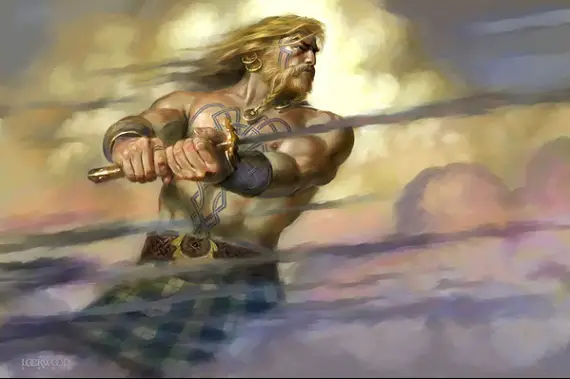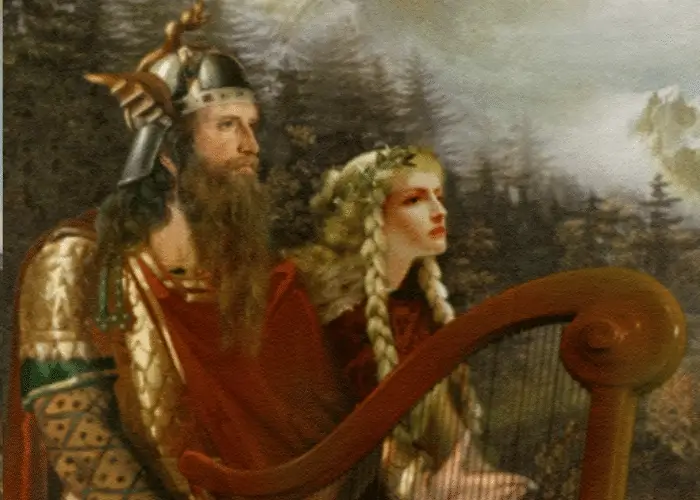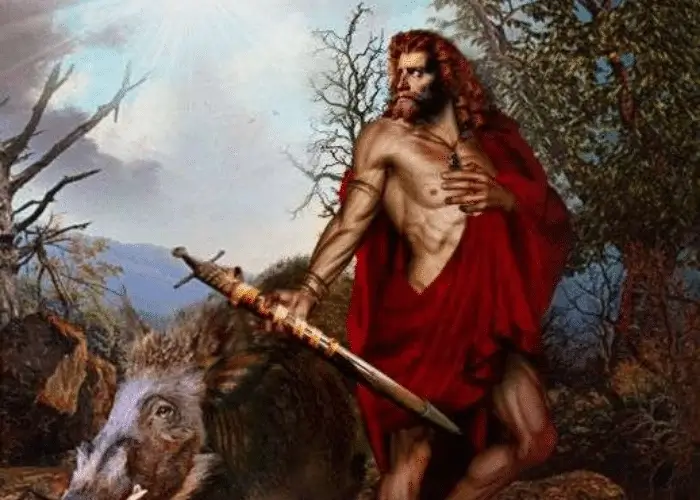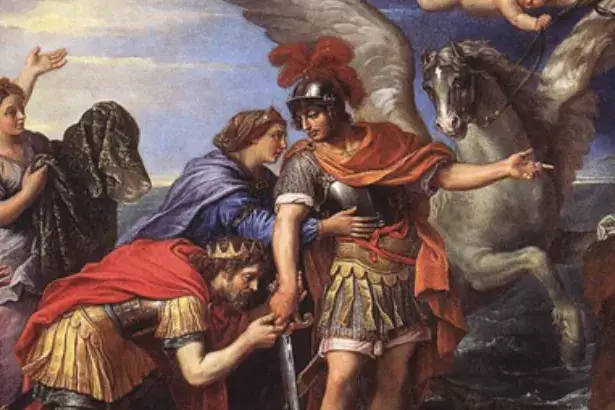Lugh – god of craftsmanship, skill, and war
Lugh is a prominent figure in Irish mythology, known as the god of many skills, including craftsmanship, war, and the arts. He is celebrated for his incredible talents and intellect, and his story has inspired many throughout the ages. In this article, we will explore the fascinating world of Lugh and his enduring legacy in Irish culture and beyond.
Brief background of Lugh’s history and portrayal in mythology
Lugh, also known as Lugh Lámhfhada, which translates to “Lugh of the Long Arm,” is a deity in Irish mythology. He is the son of the goddess Ethniu and the god Cian of the Tuatha Dé Danann. According to legend, his mother was imprisoned in a tower by her father, the Fomorian Balor, who had been told that he would be killed by his own grandson. However, Lugh was born and raised in secret and eventually led the Tuatha Dé Danann to victory against the Fomorians in the battle of Mag Tuired. In Irish mythology, Lugh is often portrayed as a powerful and wise figure, known for his many skills and talents.
Lugh’s Associations and Attributes
Lugh is primarily associated with three key attributes: craftsmanship, skill, and war. As a god of craftsmanship, he is often depicted as a master of many trades, including metalworking, carpentry, and stonemasonry. He is also considered to be a patron of the arts, particularly music, poetry, and storytelling.
In addition to his artistic abilities, Lugh is known for his exceptional physical and martial prowess, which made him a valuable ally in times of war. He was often invoked by warriors seeking victory and protection in battle. In fact, Lugh is sometimes referred to as “Lugh the Il-Dana,” or “Lugh of the Many Skills,” because of his vast range of talents and abilities.
As a god of skill, Lugh was also associated with the sun, which was seen as a symbol of light, warmth, and energy. In many legends, Lugh is depicted as a radiant figure, shining with the power and vitality of the sun.
Overall, Lugh is considered to be a multi-faceted and complex deity, representing a wide range of human qualities and attributes. He is revered in Irish mythology for his intelligence, creativity, courage, and strategic thinking, as well as his martial prowess and ability to lead and inspire others.
Lugh’s association with craftsmanship
Lugh is commonly known as the god of craftsmanship, which was an essential skill in Celtic culture. According to mythology, Lugh was skilled in a variety of trades, including metalworking, poetry, and even warcraft. His talents and knowledge made him a revered figure among the Celts, who held craftsmanship and skill in high regard. Lugh was often depicted with symbols of his craft, such as a spear or a hammer, which represented his abilities as a warrior and a blacksmith. The Celts believed that Lugh’s skills in craftsmanship were a gift from the gods and that he was responsible for passing on his knowledge to mortals.
Lugh’s association with skill
In addition to being the god of craftsmanship, Lugh was also associated with the concept of skill in general. This included not only the ability to create physical objects, but also skills such as music, storytelling, and diplomacy. Lugh was often depicted as a wise and strategic leader who could use his skills to negotiate peace or lead his people into battle. His reputation for intelligence and cunning made him a respected figure in Celtic culture, and many tales and legends celebrate his skill and ingenuity.
Lugh’s Association with War
Lugh was also known as a god of war, and his skills on the battlefield were legendary. As a skilled warrior, he was often called upon to lead armies into battle and was associated with victory and triumph. According to myth, Lugh led the Tuatha Dé Danann in their battle against the Fomorians, the ancient enemies of the Celtic gods, and emerged victorious. This battle was seen as a defining moment in Celtic mythology and cemented Lugh’s status as a powerful and important figure in their culture.
Lugh’s Origins and Mythology
Lugh is a prominent god in Irish mythology who was associated with many different aspects of life. He is known as a god of craftsmanship, skill, war, and even agriculture. Lugh was the son of Cian and Ethniu, who were both members of the Tuatha Dé Danann, a race of god-like beings who were said to have lived in Ireland before the arrival of the Celts.
According to mythology, Lugh was conceived when his father Cian transformed into a pig and was then eaten by Ethniu, who was unaware of his true identity. However, she later discovered that she was pregnant with Cian’s child and gave birth to Lugh.
Lugh was said to have been born with many special abilities, including exceptional strength, agility, and intelligence. He was also a skilled warrior and is known for his many victories in battle. Lugh is often depicted in mythology as a youthful and handsome figure, with a golden aura and a spear in his hand.
Lugh’s most famous mythological feat was his defeat of Balor, the king of the Fomorians, a race of malevolent beings who were the arch-enemies of the Tuatha Dé Danann. Balor was said to have possessed a powerful eye that could destroy anything it gazed upon, but Lugh managed to slay him with a slingshot, killing him with a single blow.
As a result of his victory, Lugh became the king of the Tuatha Dé Danann and went on to lead them in many battles against their enemies. His reputation as a skilled warrior and leader made him one of the most revered gods in Irish mythology, and his legacy continues to be celebrated in modern times.
Lugh’s birth and upbringing
Lugh’s birth and upbringing are shrouded in myth and legend. According to one version of the story, Lugh was the son of Cian and Ethniu. Cian was the son of Dian Cecht, the god of healing, and Ethniu was the daughter of Balor, the king of the Fomorians, a race of monstrous beings.
Balor had been told by a druid that he would be killed by his own grandson, so he locked Ethniu away in a tower to prevent her from having any children. However, Cian managed to sneak into the tower disguised as a woman and impregnated Ethniu.
When Balor discovered that Ethniu was pregnant, he ordered that the child be thrown into the sea. However, the child was rescued by the god of the sea, Manannan mac Lir, and raised by him.
Lugh grew up to become a skilled warrior and craftsman. He eventually learned of his true parentage and set out to avenge his father’s death at the hands of Balor. With the help of the Tuatha Dé Danann, Lugh defeated Balor and became the new king of the Fomorians.
Lugh’s role in the defeat of Balor
In Irish mythology, Lugh played a significant role in the defeat of the Fomorian king Balor, who was also his grandfather. According to the myth, Balor had a poisonous eye that could kill anyone who looked into it. Lugh, being the only one who could match Balor’s power, was chosen to lead the Tuatha Dé Danann in the battle against the Fomorians.
During the battle, Lugh faced Balor and used his slingshot to shoot a stone into Balor’s eye, killing him instantly. This victory secured Lugh’s position as a hero among the Tuatha Dé Danann and solidified his role as a powerful god in Irish mythology. The festival of Lughnasadh, which marks the beginning of the harvest season, is believed to have originated as a celebration of Lugh’s victory over Balor.
Lugh’s Importance in Irish Mythology
Lugh is considered one of the most important figures in Irish mythology, as he was a god of many domains and played a significant role in the Tuatha Dé Danann’s struggles against the Fomorians. His association with skill and craftsmanship made him a patron of the arts, while his connection to war and battle made him a popular deity among warriors.
In addition to his mythological importance, Lugh was also believed to have had a significant impact on Irish history and culture. The ancient festival of Lughnasadh, which was traditionally celebrated in August, was named after him and was a time of feasting, games, and contests in his honor. The name “Lugh” was also given to many prominent figures in Irish histories, such as the legendary High King Lughaidh Mac Con. Overall, Lugh remains a prominent figure in Irish folklore and a symbol of the country’s cultural heritage.
Lugh’s Festivals and Celebrations
Lugh has several festivals and celebrations in the Celtic calendar. The most important of these is Lughnasadh, which is held on August 1st and marks the beginning of the harvest season. This festival is named after Lugh, as he was the god of agriculture and the harvest. Lughnasadh was celebrated with feasting, games, and competitions.
Another festival associated with Lugh is the festival of Beltane, which is held on May 1st. This festival marks the beginning of summer and is associated with fertility and growth. Lugh was often honored during Beltane celebrations as a god of fertility and creativity.
Finally, there is also a festival called the Feast of Lugh, which is held on the full moon in August. This festival celebrates Lugh’s many talents and achievements and is a time to honor his role as a god of craftsmanship, skill, and war. During the Feast of Lugh, offerings are made to Lugh, and his many talents are celebrated through music, dance, and storytelling.
Lughnasadh and its Significance in Celtic Culture
Lughnasadh is one of the four major festivals celebrated in Celtic culture, and it is closely associated with Lugh, the god of craftsmanship, skill, and war. The festival takes place on August 1st, which is roughly halfway between the summer solstice and the autumn equinox.
Lughnasadh is also known as the festival of the first fruits, as it marks the beginning of the harvest season. In ancient times, people would gather together to celebrate the bountiful harvest and offer the first fruits of their labors to the gods.
One of the most important rituals associated with Lughnasadh was the cutting of the first sheaf of grain. This sheaf was then fashioned into a corn dolly or a figure of Lugh himself, which would be kept until the following year’s festival as a symbol of the harvest’s fertility and abundance.
Lughnasadh was also a time for games and competitions, which were meant to honor Lugh’s skill and prowess. These competitions included athletic events, such as foot races and wrestling matches, as well as contests of music, poetry, and storytelling.
In modern times, Lughnasadh is still celebrated by many neo-pagan and Wiccan communities, often incorporating elements of the traditional Celtic rituals and customs. The festival remains a time to give thanks for the harvest and to honor the god Lugh and his many talents and attributes.
Other festivals and celebrations associated with Lugh
Apart from Lughnasadh, there are not many other festivals specifically associated with Lugh. However, he is sometimes honored during other Celtic festivals and celebrations, such as the spring festival of Beltane, the winter solstice festival of Yule, and the autumnal equinox festival of Mabon.
During Beltane, Lugh is sometimes honored as a god of light and fire, representing the increasing light and warmth of the summer months. During Yule, he is sometimes honored as a god of rebirth, representing the returning light after the darkest days of winter. During Mabon, he is sometimes honored as a god of harvest and abundance, representing the bountiful crops and fruits of the autumn season.
In addition to these specific festivals, Lugh is sometimes honored in modern Celtic-inspired Paganism as a patron of craftsmen, warriors, and those who strive to develop their skills and talents. Some modern Pagans honor him during personal rituals and meditations, or by creating art and crafts as an offering to him.
How Lugh’s festivals are celebrated today
Today, Lugh’s festivals are still celebrated by modern Pagans and Neopagans, particularly those who follow Celtic and Irish traditions. Lughnasadh, in particular, is still widely observed as a time of harvest and feasting. Some modern celebrations may involve the reenactment of traditional games or performances, while others may focus on giving thanks for the blessings of the harvest season. Some may also use the occasion to honor Lugh and his many talents and contributions to Irish mythology and culture. Overall, Lugh’s festivals continue to serve as important reminders of the interconnectedness between humans, nature, and the divine in Celtic belief systems.
Lugh’s Influence on Modern Culture
Lugh’s influence can be seen in modern culture in various forms. For instance, there are many Irish and Celtic festivals held around the world that celebrate Lugh and his mythology. In addition, Lugh’s association with skill and craftsmanship has inspired many modern-day artists and artisans.
Furthermore, Lugh’s association with war and courage has been a source of inspiration for many people, particularly those in the military. The name “Lugh” has been used in military operations, such as the US Army’s Operation Lugh Legacy in Afghanistan, which aimed to train Afghan security forces.
Moreover, Lugh has been portrayed in various forms of media, including literature, music, and film. For instance, the character Lugh is featured in Kevin Hearne’s Iron Druid Chronicles and in Rick Riordan’s The Trials of Apollo series. Additionally, Lugh is referenced in the song “The Battle of Evermore” by Led Zeppelin.
Overall, Lugh’s influence can be seen in various aspects of modern culture, and his legacy continues to be celebrated and remembered.
Conclusion
In conclusion, Lugh is a complex and fascinating figure in Irish mythology, known for his associations with craftsmanship, skill, and war. His story of triumph over Balor has been passed down through the generations and his festivals continue to be celebrated today. Lugh’s influence can also be seen in modern culture through various artistic works and representations. Overall, Lugh’s legacy as a god of great skill and bravery lives on and continues to inspire people to this day.






